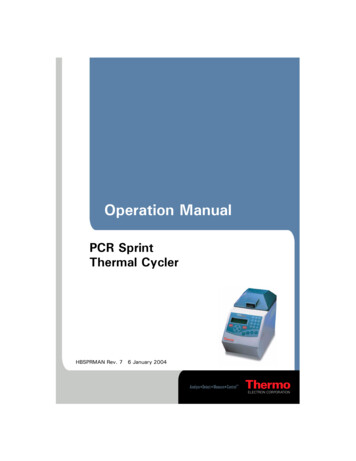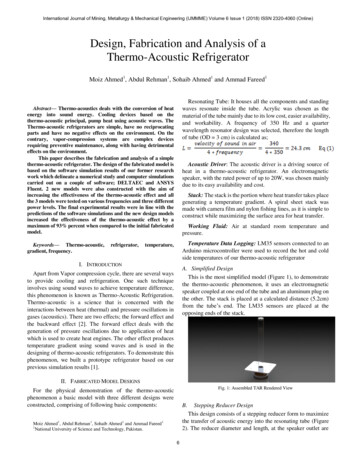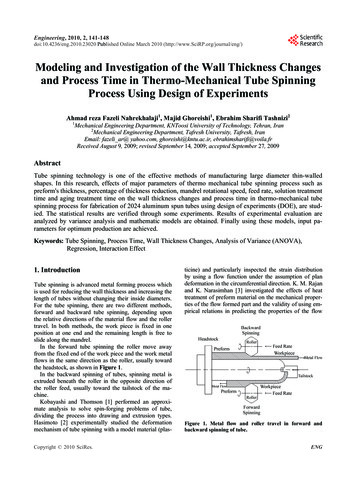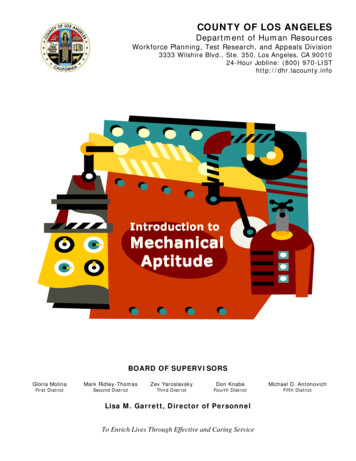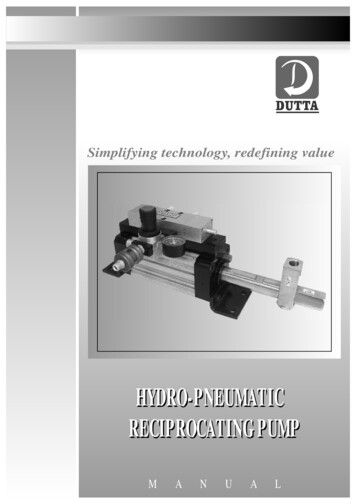
Transcription
Introduction toThermo-hydro-mechanical (THM)Wood ProcessingDick Sandberg and Parviz NaviPrice 175 SEK, Available fromSchool of Technology and DesignVäxjö UniversitySE-351 95 Växjö Swedenwww.vxu.seISSN: 1652-8433ISBN: 978-91-7636-561-8School of Technology and DesignReports, No. 30Växjö UniversityVäxjö, Sweden 2007
Introduction toThermo-hydro-mechanical (THM)Wood ProcessingDick Sandberg and Parviz NaviReport No. 30ISSN: 1652-8433ISBN: 978-91-7636-561-8Copyright 2007 Dick Sandberg and Parviz Navi
1
PrefaceWood is the ultimate renewable material. It possesses qualities that havemade it a material of choice for millennia, these qualities further enhancedby its recognised carbon sequestration. However, as a biological materialit suffers the same fate as any natural material, namely degradation. Thereare ways in which wood can be enhanced, including eco-friendly methods.One of the emerging eco-friendly methods is the combined use oftemperature, moisture and mechanical action – so-called Thermo-HydroMechanical (THM) treatments.THM processing can improve the intrinsic properties of wood, to producenew materials and to acquire a form and functionality desired by engineerswithout changing its eco-friendly characteristics. There are numerousTHM processing techniques and the number of these processes is growingcontinuously.THM processing can be divided into two major categories; ThermoHydral treatments (TH) and Thermo-Hydro-Mechanical treatments(THM). TH is usually used to enhance wood properties, and is ofimportance in increasing stress relaxation during drying under hightemperature, in the formation of wood-based composites or veneerproducts and in the artificial ageing of wood. THM on the other hand, isemployed in the producing of new materials by densification, shaping bymoulding, welding of wood by friction, embossment, bending of wood,wood fusion, and chip-less manufacturing. During THM treatment, woodundergoes large deformation, stress relaxation and chemical degradation,but with strong shape memory depending on parameters like temperature,moisture content, applied forces, processing time and the type of wood.Several TH and THM processes have recently been developed in Europe,Japan, the USA and Canada, but only some of them have been scaled-upindustrially. However, to overcome the problems associated withTH/THM wood during processing at the laboratory scale, during scale upand controlling the end use properties, a detailed knowledge of thesephenomena becomes important. This requires a close collaborationbetween experts in wood chemistry, wood mechanics and material sciencefrom both academia and from industry.I
With this report we would like to give a brief state-of-the-art of theimportant field of THM-processing. The aim of this work has not been tocover the complete field of THM-processing, just give an introduction.Dick Sandberg and Parviz NaviII
Contents1 WOOD MODIFICATION .11.1 INTRODUCTION .11.2 MODIFICATION OF WOOD .21.2.1 Chemical modification .31.2.2 Thermo-hydro-mechanical treatments, THM.51.3 REFERENCES .142 ANCIENT USES OF THERMO-HYDRO-MECHANICAL PROCESSES.172.1 INTRODUCTION .172.2 WOODLAND CRAFTS .222.2.1 Bending of solid wood in woodland craft.222.3 THM-PROCESSING IN THE CONSTRUCTION OF WOODEN VESSELS.242.4 THE MANUFACTURE OF WOODEN CASKS .352.4.1 traditional coopering.352.4.2 Machine coopering.402.5 THE INDUSTRIALIZATION OF SOLID WOOD BENDING .422.5.1 The Thonét process .432.5.2 The Vienna Chair which conquered the world.452.5.3 What was it that made the Thonét method so successful? .472.6 THE USE OF VENEER FOR CURVED SHAPES .492.7 REFERENCES .583 ELASTO-VISCOPLASTICITY OF WOOD UNDER THERMO-HYDROMECHANICAL ACTIONS .653.1 COMPRESSIVE FORMING OF MASSIVE WOOD BY THM ACTIONS .653.1.1 Historical background.663.2INTRODUCTION TO THE ELASTIC, PLASTIC AND VISCOELASTIC BEHAVIOR OFWOOD UNDER CONSTANT AND VARIABLE CLIMATIC CONDITIONS .703.2.1 Behavior of wood under mechanical loading.703.2.2 Instantaneous elastic response.713.2.3 Mechanisms of wood cellar deformations under longitudinal compression .743.2.4 Deformation of wood under compression in the radial and tangentialdirections.773.2.5 Constitutive equations of an elastic orthotropic material .793.2.6 Constitutive equations for the large nonlinear deformation of materials .823.3 ELASTO-VISCOPLASTIC BEHAVIOUR OF WOOD CONSTITUENTS UNDER THERMOHYDRO-MECHANICAL (THM) ACTIONS AT TEMPERATURES UNTIL 200 C.853.3.1 Introduction.853.3.2 Glass transition temperature of amorphous and semi-crystalline polymers .87Glass transition temperature (Tg) of wood components.883.3.3 Influence of temperature and humidity on the hygro-plasticity of wood.923.3.4 Influence of temperature on the thermal degradation of wood .95III
3.3.5 Deformation of the cellular structure of spruce during transversecompression .983.4 CHEMICAL DEGRADATION OF WOOD CONSTITUENTS UNDER THERMO-HYDROMECHANICAL (THM) ACTIONS AT TEMPERATURES UNTIL 200 C .1053.4.1 Reactivity of the wood components in acid conditions.105Effects of temperature and moisture content.1053.4.2. Reactivity of polysaccharides.106Reducing terminal .106Glucosidic links.106The hydroxyl groups.1063.4.3 The hydrolysis of polysaccharides .107Factors influencing the hydrolysis .1093.4.4 Dehydration and condensation reactions.1103.4.5 Reactivity of the cellulose microfibrils .111Characteristics of the cellulose microfibrils .1113.4.6 Reactivity of hemicelluloses .113Xylans.114Glucomannans .1143.4.7 Reactivity of lignin .115Reactivity of the bonds ether .115Reactivity of the hydroxyl groups.115Reactivity of the lignin-carbohydrate complex.1163.4.8 Physicochemical modifications of wood components during THM postprocessing .116Quantitative analysis of hemicelluloses by GPC.116Determine of the degree of polymerization of cellulose by capillary viscometry.118XRD determination of the degree of crystallinity of the cellulose microfibrils .119Determination of the glass transition temperature ( Tg ) of lignin by DSC.1233.5 SHAPE MEMORY OF DENSIFIED WOOD AND FIXATION THE COMPRESSION-SET BYTHM TREATMENTS .1263.5.1 Wood deformation during densification at cell wall ultra-structure andmolecular level.1263.5.2 Origin of the shape memory or recovery of compression-set of densified wood.1293.5.3 Cells recovery of densified wood.1303.5.4 Elimination of shape memory of densified wood by THM treatment .1313.5.5 Multi-parametric THM reactor .1333.5.6 Densification by THM actions.135Post-treatment by THM actions .136Set recovery test .1373.5.7 Experimental results of compression-set recovery of densified wood treatedby THM actions under saturated and unsaturated steam conditions .1393.5.8 Role of hemicelluloses hydrolysis on fixation of compression-set.1413.6 REFERENCES .145IV
4 WOOD BENDING.1514.1 INTRODUCTION .1514.2 SOLID WOOD BENDING .1514.2.1 The theory of plastic forming .1514.2.2 Choice of wood species .1584.3 Pre-treatment of the wood.1604.4 Shaping.1624.5 Finishing .1664.6 REFERENCES .167V
VI
1Wood Modification1.1 IntroductionThe polymeric components of wood and their multilevel hierarchicalarrangement in the wood structure confer a noble, versatile and generalpurpose character on wood and a faculty for transformation exceeding thatof all other materials. The unique advantages of this material, its greatavailability, sustainable renewal, favourable ecological assessment andflexibility of implementation, give this worthy material its letters patent ofnobility in the eyes of scientists and engineers.Wood and bark are special materials fabricated by the tree which exertcertain quite specific functions and their development is controlled bygenes to meet the needs of the tree. The anatomical structure of woodaffects its strength properties, appearance, and resistance to penetration bywater and chemicals, resistance to decay, pulp quality, and chemicalreactivity. To use wood most effectively requires a knowledge not only ofthe relative amounts of the various substances that make up the wood butalso how these substances are distributed in the cell walls and how theyreact to the environment. The fact that wood is a natural product comingfrom different individual trees imposes limits on its use. This naturalmaterial may need to be transformed in order to acquire the desiredfunctionality. Specific problems which mean that wood does not alwayssatisfy the requirements of the users, are: its lack of uniformity, the fact that its dimensions are limited to those of the tree, its anisotropic and hygroscopic character, leading to importantdimensional variations, its heterogeneity, its weak resistance to bio-degradation by micro-organism and tofire.The purpose of any technological development with regard to wood is thusto standardize, to homogenize, to give to the end product dimensions and1
shape that are independent of the dimensions of the tree, to decreaseanisotropy, to overcome the problems of dimensional instability andimprove its durability and resistance to fire. To obtain semi-finished andfinished products with or without added value, wood can be transformed invarious ways: by the first transformation of the wood, i.e. sawing, chipping, pulpmaking etc., by reconstitution of the wood, by modification of the wood.In this book, it is intended to review the principal elements of the thermohydro-mechanical (THM) behaviour of wood, the rich experience gainedduring millennia of wood THM technology and the present implementationof THM modified wood.1.2 Modification of woodIn addition to the preservation or fire protection of wood, the most commonreason for modification of wood is to reduce the rate at which moisture issorbed by the wood (water repellence) and/or reduce the shrinking andswelling that occur at equilibrium under conditions of fluctuating relativehumidity, i.e. improve the dimensional stability. These modificationmethods include plasticization or softening of the wood. This is anextremely important part of the processes for solid wood bending, veneercutting, pulp making etc. What actually happens in the wood during theplasticization has been explained more and more in the last years and willbe described in more detail in the coming chapters.To modify wood, two types of treatment are applied: chemical treatmentand thermo-hydro-mechanical treatment. The chemical treatments are muchmore numerous and the range of the chemicals available is also very broad,whereas in the THM treatments, only heat, water and mechanical forces areused. Figure 1.1 presents a simplified synoptic diagram of chemical andTHM treatments, which are implemented at the present time.2
Figure 1.1A diagram of the various processes for the modification ofwood.1.2.1 Chemical modificationChemical modification of wood is defined as any chemical reactionbetween some reactive part of a wood cell component and a chemicalreagent, with or without catalyst that forms a covalent bond between thetwo components (Hon & Shirashi, 1991; Hill, 2006). The most promisingapplication of the technology developed for the chemical modification ofwood is in the area of reconstituted products, e.g. particle boards, plywoodand veneer-based products. Problems of dimensional instability andbiological degradation restrict the use of wood products on many marketsand the value added to these by chemical modification may be such that thetreatments become more economically feasible.In figure 1.1, two classes of chemical treatments can be distinguished:subversive and soft. The subversive treatments are able to enter the core of3
the cellulose fibrils. They break down of the crystalline structure ofcellulose and eliminate the multilevel and hierarchical structure of wood.These treatments radically modify the chemical components of wood.Consequently, the material produced loses practically all the intrinsiccharacteristics of untreated natural wood. Examples of subversivetreatments are liquefactions and oilification of lignocelluloses given inYosluoka et al. in Hon (1996). They refer liquefaction mainly to thoseprocedures for producing oil from biomass under very severe condition.Appel et al. (1969, 1975) converted celluloses to oil by using chemicalreactive, high heat and pressure. This type of liquefaction is calledoilification of lignocelluloses. Other recent types of liquefaction considerthe dissolution of chemically modified wood or even untreated wood in asolvent. Applications of these types of liquefactions have been developed inthe preparation of adhesives, mouldings, foam and so on.The soft chemical treatments, on the other hand, leave the crystallinestructure of wood intact and touch only the amorphous part and the sidegroups (functional groups) of the wood components at the molecular level.These treatments leave the microstructure of modified wood more or lessunchanged. In this category, some typical treatments are: formaldehydation,acetylation, etherification, impregnation by carbinol and maleic acid,impregnation by vinyl resins, impregnation by polyethyleneglycol (PEG),impregnation by phenolformaldehyde resin, filling by metal alloys at lowmelting point, etc. These treatments lead to improvement in certain physicaland mechanical properties of wood like hygroscopicity, resistance to microorganisms, fire resistance and its mechanical behaviour with respect to themoisture variations. Norimoto and Grill (1993) have investigated theinfluence of various soft chemical treatments on the mechanical andphysical properties of wood, and they have shown that some treatmentsimprove certain properties of wood but are likely to lead to deterioration inothers. For example, acetylation improves hygroscopicity and reduces themechano-sorptive creep. In addition, the impregnation of wood by apolyethyleneglycol (PEG) resin improves the hygroscopicity of wood butthe same time increases the mechano-sorptive creep.The chemical treatments which involve radical modifications of thestructure of wood, i.e. subversive chemical treatments constitute a delicatefield which requires a detailed study of the organic chemistry and is outsidethe framework of this work. The soft chemical treatments are however4
covered in this work with a description of their effects on thehygroscopicity and softening of wood.1.2.2 Thermo-hydro-mechanical treatments, THMThe THM treatments have an important advantage over the chemicaltreatments because the products of the THM wood are particularlyenvironment friendly. Indeed, during THM processing the chemical natureof the various components of wood is not basically changed.The THM treatments include many types of process: Wood bending, i.e. solid wood bending and laminated bending. Densification: thermo-mechanical (TM) in an open system, andthermo-hydro-mechanical (THM) in a closed system. Wood shaping, surface densification, embossment, wood crosssectional transformation. Wood welding and wood surface fusion. Heat treatment for increased dimensional stabilization andimproved resistance to decay. Thermal-hydro processing of wood, i.e. wood plasticizing, knownunder wet heating to release the internal stresses and to soften ofwood. Reconstituted wood products refer to any number of compositesthat contain wood, e.g. paper, different types of fibre boards,plywood and wood plastic composites.The fact that wet wood can be shaped under the action of mechanical andthermal loads has been known for a very old time. Figure 1.2 shows theprinciples in the construction of a canoe by an elementary and ancient THMprocess. The various stages of construction are: preparation of the hullstarting from a trunk, heating of the hull of humidified wood, giving thedesired shape to the canoe and fixing the given shape.The shaping of steamed wood has been practical since antiquity and hasbeen carried out in many different ways. Plasticization of the solid wood inorder to make it possible to bend the wood piece without fracture is the5
(a) Use of mallets and wedges tohollow out the interior of thetrunk. Scraping the trunk to giveit the desired thickness; onefinger thickness for the upper partand two fingers for the bottom.a)(b) In order to widen the canoe andgive it the final shape, it is filledwith water to humidify the wood.The water is then heated to boilingby heated stones. The fire lit at theside also heats the outside of thecanoe. Once the wood has beensoftened by the hot water and fire,the wooden beams are set up towiden the hull, fixing andmaintaining the desired shape.b)Figure 1.2The construction of a canoe, taken from “La Grandeaventure des Indiens d Amérique du Nord” (Freed &Baby, 1983).most common way of shaping, e.g. for furniture making and shipconstruction. The bending can be achieved in one or in two planes and indifferent directions in the same plane. Wood is normally bent, after presteaming, in various types of strapping devices that minimize the effect oftension on the convex surface and maximize compressive yield on theconcave surface, thus minimizing the risk of breakage.Another process involving the shaping of wood is the technique of laminatebending that is primarily directed towards the bending of veneers for otherthan structural purposes, such as in furniture, sports goods, furnishingdetails etc (Stevens & Turner, 1970). To increase the efficiency of themanufacturing process of wood veneer products an the increasingimportance of laminated bends in structural applications has led toincreasing interest in a basic understanding of the wood material and the6
process (Ormarsson & Sandberg, 2007). The fundamental mechanisms thatmust be understood to enable an efficient manufacturing process to bedeveloped for bending laminated wood for structural purposes and for nonstructural members are however similar, especially when the radius ofcurvature is small. Figure 1.3 shows examples of products made by solidwood bending and laminated bending.Wood can be densified and its properties modified not only by filling itsvoid volume with polymers, molten sulphur, or molten metals but also bycompressing it under conditions such that the structure is not fractured.Densification is the process where the wood density is increased byreducing the void volume of the lumens in the wood material. This iscommonly achieved by compressing the wood in the transverse direction.The first aim of the densification is to improve the mechanical and moisturesorption behaviour of the wood. In spite of the improvements in theproperties, untreated densified wood had a tendency to recover all or part ofits compression set when it is subjected to heat and high humidity. Thisphenomenon is called “shape memory” or “set-recovery”. Nevertheless, atpresent the main aim of wood densification is multitude, and includes manydifferent processes.Embossment is a process where the surface of the wood is densified,normally by a steel tool, to create a decorative pattern in the wood surface,Figure 1.4.a)Figure 1.3b)Examples of products made by solid wood bending (a) andlaminated bending (b).7
This method is comparable with the methods of densification of wood, butthe main purpose of this process is not to increase the density of the wood,but only to shape the wood surface. Embossment has a long tradition and,for example, the art of pressing, engraving and fretting patterns into woodhas been a part of Iran's ancient history and goes as far back as 5000 yearsfor the interior design of palaces, boxes laid over tombstones, pulpits andbook-racks (Khamouski, 1999).Already in 1886, the idea of densifying wood by compressing it in theradial direction was understood (Vorreiter, 1949). In Austria, the Plumfesbrothers developed a method in 1922 for densifying the wood byimpregnation with rubber. This type of wood was applied in the aviationindustry until 1945 when it was replaced by aluminium. Compressed solidwood has also been made in Germany since the early nineteen thirties andmarketed under the trade name of Lignostone, a corresponding laminatedcompressed wood under the trade name of Lignofol, and a resin-treatedlaminated compressed wood under the name of Kunstharzschichtholz(Kollmann, 1936; Stamm, 1964). To overcome the problem of shapememory, Stamm and Seaborg (1941) impregnated the wood after itscompression with a resin of phenol formaldehyde and the wood was heatedfor 10 to 20 minutes to polymerize the resin. This type of compressed andimpregnated wood was called “Compreg”. Later, they improved the processusing a thermo-hydro treatment to decrease the shape memory. Thisproduct was called “Staypak”.Figure 1.4Example of embossment works.8
The modification of wood by heating to improve its permanence anddimensional stability was also studied by Stamm et al. (1946). Wood washeated in baths of molten metal at temperatures between 140 and 320 C,and it was reported that heating for seven hours at 260 C reduced theswelling of Sitka spruce by 60 %. However, Stamm (1964) reported that,although the dimensional stability and permanence of compressed woodwere improved by heating, certain strength parameters were reduced to anunacceptable level, particularly the surface strength. Stamm predicted nogreat future for the use of heat-stabilized wood. On the other hand, he didnot predict the strong awakening of environmental issues towards the endof the century. Studies of the thermal treatment of wood above 300 C areof limited value, due to sevre degradation of the material (Hill, 2006).In the 1970s, Burmester (1973) studied the effects of temperature, pressureand moisture content to find the optimum conditions for the heatstabilization of different sorts of wood, and a heat-treatment method calledFWD (Feuchte-Wärme-Druck) was launched. The optimum conditions fore.g. pine wood were stated to be a moisture content of 20 30 %, atemperature of 160 C and a pressure of 0.7 MPa. A considerable resistancetowards brown rot fungus was reported, and the strength reduction wasstated to be insignificant.Recently Norimoto et al. (1993) and Ito et al. (1998a) used the sameprocess as Stamm and Seaborg to eliminate the memory shape of densifiedwood. Advanced investigations of the densified wood treatments by theTHM processing have recently been reported by Tanahashi (1990), Inoue etal. (1993), Ito et al. (1998b), Navi and Girardet (2000), Heger (2004), Naviand Heger (2005) and Navi et al. (2007). They have shown that the THMpost-treatment of densified thin wood specimens at 200 C for only 4minutes is sufficient to eliminate almost totally the shape memory of thewood. Recent research on the shaping, moulding and densification and theTHM post-treatments of compressed wood seek to widen their fields ofapplication.In the case of friction welding, the thermal energy generated by friction,which is usually undesirable, is used to join materials by encouraging wearin a controlled way, leading to efficient welding. For several decades,friction welding has found broad applications in many fields of the metaland plastic industries. The fabricated joints are laminar or punctiform,depending upon the shape of the parts to be welded. Suthoff et al. (1996)made the first attempts to join wood by means of pressure and frictional9
heat. It is stated that two pieces of wood can be welded by means of anoscillating or linear frictional movement.The wood in the contact zone is heated by means of frictional heat. Thiscauses a thermal alteration of the wood cell structure which leads to theformation of a viscous layer. After cooling, the material in this layer formsthe connection, Figure 1.5. The friction welding process of wood bears adistinct resemblance to the friction welding of metals and thermoplastics.As with metals and plastics, the friction welding of wood can be dividedinto different phases by measuring the frictional force, and these phasesreflect the particular states of the interface, i.e. dry friction, transition phaseand viscous state.Investigations by Gfeller et al. (2004) and Stamm (2006) of the evolution ofthe interfacial resistance showed that the welded connections do notdevelop the strength achievable by conventional glues. However, therelatively high initial resistance permits the continuous welding ofmultilayered laminates.Mechanically induced vibration wood fusion welding techniques can alsobe used to obtain wood surface finishes of increased surface hardness andperformance in presence of polymerizing unsaturated oils such as sunfloweroil, or other polymerizing finishes (Pizzi et al., 2005).Figure 1.5Confoc
extremely important part of the processes for solid wood bending, veneer cutting, pulp making etc. What actually happens in the wood during the plasticization has been explained more and more in the last years and will be described in more detail in the coming chapters. To modify wood

